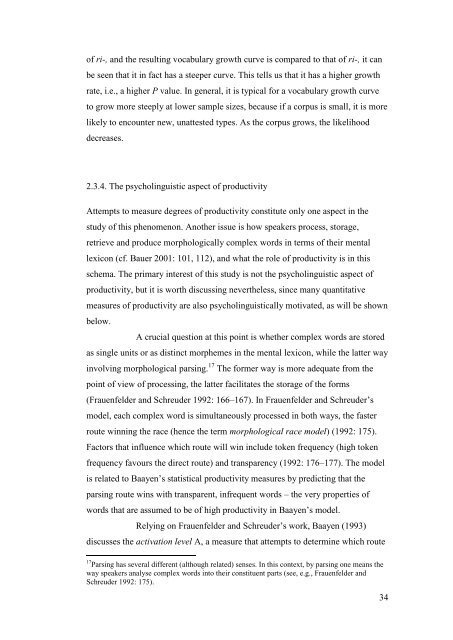The morphological productivity of selected ... - Helda - Helsinki.fi
The morphological productivity of selected ... - Helda - Helsinki.fi
The morphological productivity of selected ... - Helda - Helsinki.fi
Create successful ePaper yourself
Turn your PDF publications into a flip-book with our unique Google optimized e-Paper software.
<strong>of</strong> ri-, and the resulting vocabulary growth curve is compared to that <strong>of</strong> ri-, it can<br />
be seen that it in fact has a steeper curve. This tells us that it has a higher growth<br />
rate, i.e., a higher P value. In general, it is typical for a vocabulary growth curve<br />
to grow more steeply at lower sample sizes, because if a corpus is small, it is more<br />
likely to encounter new, unattested types. As the corpus grows, the likelihood<br />
decreases.<br />
2.3.4. <strong>The</strong> psycholinguistic aspect <strong>of</strong> <strong>productivity</strong><br />
Attempts to measure degrees <strong>of</strong> <strong>productivity</strong> constitute only one aspect in the<br />
study <strong>of</strong> this phenomenon. Another issue is how speakers process, storage,<br />
retrieve and produce <strong>morphological</strong>ly complex words in terms <strong>of</strong> their mental<br />
lexicon (cf. Bauer 2001: 101, 112), and what the role <strong>of</strong> <strong>productivity</strong> is in this<br />
schema. <strong>The</strong> primary interest <strong>of</strong> this study is not the psycholinguistic aspect <strong>of</strong><br />
<strong>productivity</strong>, but it is worth discussing nevertheless, since many quantitative<br />
measures <strong>of</strong> <strong>productivity</strong> are also psycholinguistically motivated, as will be shown<br />
below.<br />
A crucial question at this point is whether complex words are stored<br />
as single units or as distinct morphemes in the mental lexicon, while the latter way<br />
involving <strong>morphological</strong> parsing. 17 <strong>The</strong> former way is more adequate from the<br />
point <strong>of</strong> view <strong>of</strong> processing, the latter facilitates the storage <strong>of</strong> the forms<br />
(Frauenfelder and Schreuder 1992: 166–167). In Frauenfelder and Schreuder’s<br />
model, each complex word is simultaneously processed in both ways, the faster<br />
route winning the race (hence the term <strong>morphological</strong> race model) (1992: 175).<br />
Factors that influence which route will win include token frequency (high token<br />
frequency favours the direct route) and transparency (1992: 176–177). <strong>The</strong> model<br />
is related to Baayen’s statistical <strong>productivity</strong> measures by predicting that the<br />
parsing route wins with transparent, infrequent words – the very properties <strong>of</strong><br />
words that are assumed to be <strong>of</strong> high <strong>productivity</strong> in Baayen’s model.<br />
Relying on Frauenfelder and Schreuder’s work, Baayen (1993)<br />
discusses the activation level A, a measure that attempts to determine which route<br />
17 Parsing has several different (although related) senses. In this context, by parsing one means the<br />
way speakers analyse complex words into their constituent parts (see, e.g., Frauenfelder and<br />
Schreuder 1992: 175).<br />
34
















